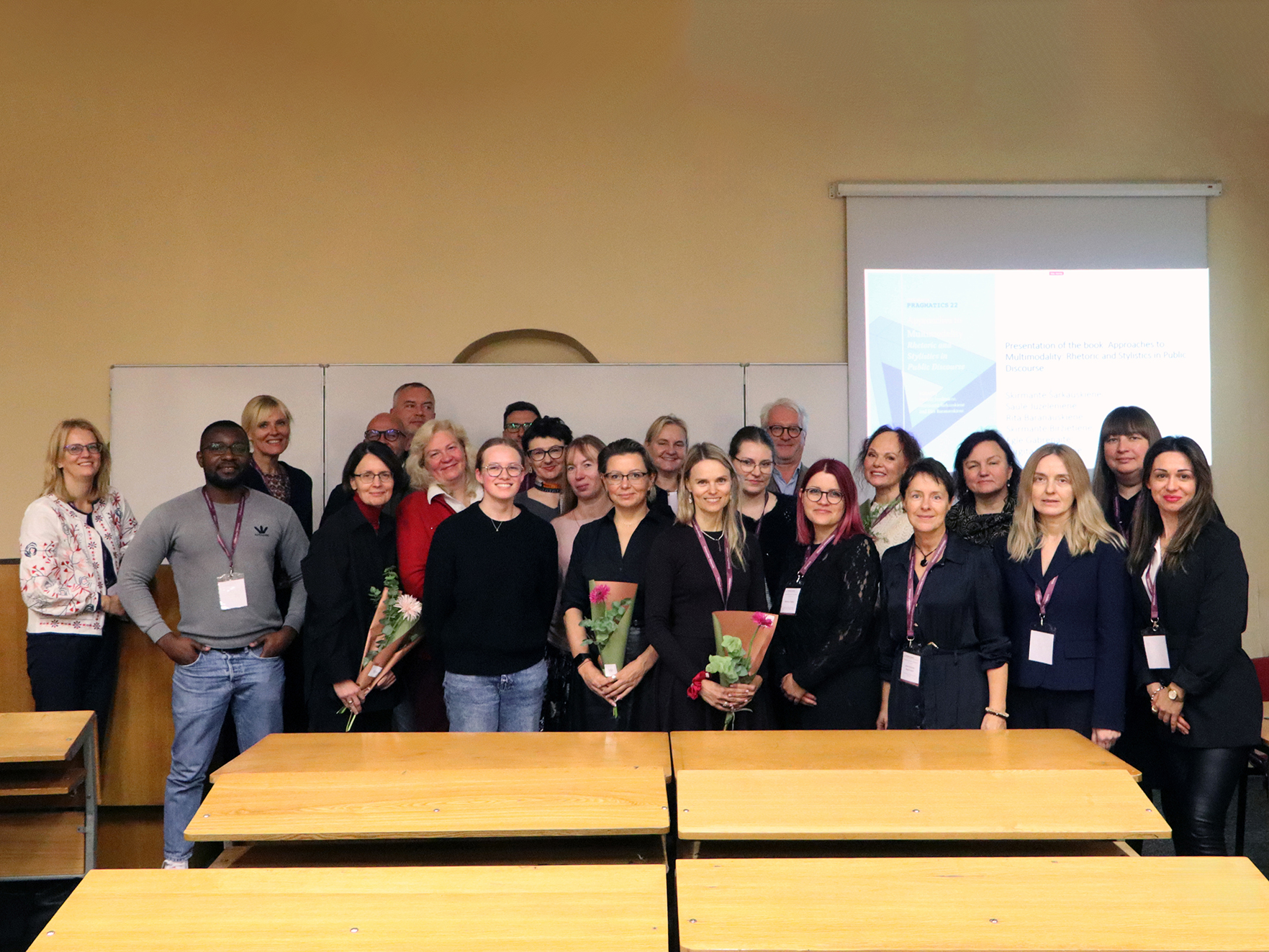 The conference “Beyond Words: persuasive narratives and multimodal discourse”, organised by the research group “Multimodality in Public Discourse”, Vilnius University Kaunas Faculty, Institute of Languages, Literature and Translation Studies, aimed to reveal the symbiosis of language, visuals, and narratives in constructing persuasive communication. Experienced, renowned, and young scholars from Canada, Ukraine, Poland, Romania, the Netherlands, Finland, Ethiopia, USA, Italy, Albania, India, Bulgaria, South Korea, Croatia, Serbia, Belgium, UAE, France, UK, Czech Republic, Kuwait and, of course, Lithuania presented the results of their research on various topics related to multimodal discourse. The discussions on whether humans will preserve language as a distinctive feature in the face of increasingly daring other forms of communication, the burgeoning influence of artificial intelligence driven by linguistic models, etc. took place.
The conference “Beyond Words: persuasive narratives and multimodal discourse”, organised by the research group “Multimodality in Public Discourse”, Vilnius University Kaunas Faculty, Institute of Languages, Literature and Translation Studies, aimed to reveal the symbiosis of language, visuals, and narratives in constructing persuasive communication. Experienced, renowned, and young scholars from Canada, Ukraine, Poland, Romania, the Netherlands, Finland, Ethiopia, USA, Italy, Albania, India, Bulgaria, South Korea, Croatia, Serbia, Belgium, UAE, France, UK, Czech Republic, Kuwait and, of course, Lithuania presented the results of their research on various topics related to multimodal discourse. The discussions on whether humans will preserve language as a distinctive feature in the face of increasingly daring other forms of communication, the burgeoning influence of artificial intelligence driven by linguistic models, etc. took place.
“We are glad that the Kaunas Faculty has managed to bring together multimodality researchers. Such a wide geography of conference participants allows us to understand the interconnectedness of text, image, sound, gestures and narratives in forming persuasive communication in a much wider cultural context. The discussions have generated ideas for further research that could shed light on the growing importance of multimodal discourse in contemporary communication," said the Associate Professor and the Chairperson of the Organizing Committee Saulutė Juzelėnienė (Vilnius University, Lithuania).
The authors of the presented research impressed with their horizon-expanding discussions
Sophia Diamantopoulou, Associate Professor at the Institute of Culture, Communication and Media, University College London, presented a study that draws on museums and schools to investigate how students use gestures and movements to convey the meanings of mathematics they have created in order to demonstrate their understanding of mathematical concepts. The presentation explored the methodological and theoretical foundations for investigating the role of movement and gesture as key modes of expression in institutional settings, particularly in terms of construction of meaning.
Odeta Žukauskienė, Senior Research Fellow at the Lithuanian Culture Research Institute and Associate Professor at the Kaunas Faculty of Vilnius Academy of Arts, presented her research on the emergence of the inhuman in the humanities, social sciences and the arts, with a particular focus on art theory and artistic practice related to various inhuman things. She is interested in how humans coexist, cooperate and interact with non-human beings, including plants, animals and other organisms, as well as with environmental elements and ecosystems. The discussion raised the question of whether the ways in which other elements communicate can be called language.
Charles Forceville, Associate Professor of Media Studies at the University of Amsterdam, well-known for his research on multimodality, impressed the conference participants not only with the depth of his scientific thought, but also with the intellectual wit of his research on the development of multimodal metaphor theory into a multimodal trope theory. He notes that it took centuries for the study of metaphor to become really popular, even though it has always been considered a matter of thought. Forceville took the idea seriously and began to study metaphor in ways other than language, focusing on the visual mode. He recognises that there are still many combinations of modes, many genres and many media to be studied, but the work needs to expand in another direction, and he is happy to dive into questions that require coherent reflection and the hard work of scholars who combine their knowledge of rhetoric, visual and multimodal analysis. He speaks boldly about the problems that scholars who intend to expand classical verbal rhetoric into a "conceptual/multimodal theory of tropes" have to address.
As the power of language influence grows, so does the importance of community
"It seems that the various discussions have really succeeded in revealing the symbiosis of language, image and narrative in the construction of influential communication. It is encouraging to see that experienced, renowned and young scholars not only present their research results on various topics of multimodal discourse, but are also open to colleagues' observations, insights and provocations for further research," said the Conference Chairperson of Scientific Committee, Assoc. Prof. Skirmantė Šarkauskienė. She stressed the importance of live meetings in an increasingly digital society, which is facing the consequences of pandemics and geopolitical threats, where the language becomes both a significant weapon, a hope for the survival of nations, and a key to coded communication across different discourses.
Abstracts of the conference presentations will be published in an online publication. Articles based on the conference presentations may be submitted to the scholarly journal “Respectus Philologicus”.